 Customers have good reasons for relying on pest management professionals. Perhaps they’ve tried and failed to deal with an ant infestation on their own, or they’re simply overwhelmed by the scope of the problem. Whatever the reason, a thorough and effective job of insect control will ensure customer satisfaction, build business, and enhance your company’s reputation. For professionals, the job of controlling structure-infesting ants is a five-step process:
Customers have good reasons for relying on pest management professionals. Perhaps they’ve tried and failed to deal with an ant infestation on their own, or they’re simply overwhelmed by the scope of the problem. Whatever the reason, a thorough and effective job of insect control will ensure customer satisfaction, build business, and enhance your company’s reputation. For professionals, the job of controlling structure-infesting ants is a five-step process:
1. Inspection: The first step is a thorough inspection to locate foraging trails, ant colonies and conditions conducive to ant infestations. Remember, more than one species may be found in and around a structure. When inspecting for foraging workers, pay close attention to “lines” where ants like to travel, such as expansion cracks in driveways and sidewalks and along foundation walls, fence lines, etc.
2. Identification: The ant species’ peculiar habits and biology will help you find where the colony or colonies are located and develop the most cost-effective control strategies. If unsure, collect specimens for positive identification.
3. Recommendation: Present the customer with an Integrated Pest Management (IPM) program that addresses the current problem and identifies conditions that may contribute to the infestation. Correcting these conditions helps prevent future infestations.
4. Treatment: In most cases, effective control includes a pesticide application in combination with nonchemical control procedures that eliminate conditions conducive to ant infestations, such as exclusion, trimming vegetation away from the structure, eliminating moisture problems, removing dead wood, etc.
5. Evaluation: The key to long-term customer satisfaction is to follow up and assess the effectiveness of your service measures. Of all insects that infest buildings, ants are the most common. Each ant species is unique in terms of nesting sites, habits, characteristics and feeding preferences.